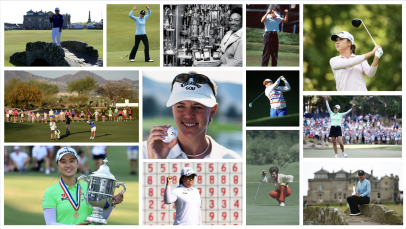The golf swing is a combination of tilts, turns, and bends. Lots of different parts of your body turn, tilt and bend when you swing a golf club. But one of the most important is a movement called side bend.
It’s a term you may have heard before.
Side bend is this kind of reverse C shape on the downswing. In every good golf swing, the lower body shifts ahead of the upper body as the club approaches impact, which tilts the upper body back. The gap between the upper and lower body increases, and that’s what creates side bend.

Anyway, side bend is really important for a bunch of reasons. One of them being that it helps golfers hit up on the ball with their driver, which helps them hit the ball further. But side bend in some ways is like adding salt to your food. Don't add enough and your food will taste bland. Add too much, and it ruins the meal, and it’s bad for your healthy. You need just the right amount.
Many amateur golfers usually don’t create enough side bend. Their lower body stays back as upper body goes forward, which causes them to get steep, over the top, and hit big slices.

But junior golfers and pros, who have lots of flexibility, tend to create too much side bend.
And that’s what was happening to Zalatoris. As Zalatoris started his downswing, his lower body would drive aggressively forward as his upper body hung back.
You can watch the full video about Zalatoris' golf swing right here:
All that side bend meant that as Zalatoris’ rotated through, his right hip would begin to rise as he while the right side of his lower back stayed down
When this kind of excessive side-bending happens it compresses and crunches the L4 and L5 discs in his lower spine. That’s a problem, because as a study by Dr. David Lindsay explains, those discs in the back don’t have much muscle or bone to protect them.

If you’re a junior golfer watching this, or a parent of a junior golfer, it’s an important concept to understand, because when these discs start “sheering together” it can create a lot of lower back pain and injury.
Morgan et al. (39) noted that on the downswing both left axial rotation velocity and right side-bending angles reached peak values almost simultaneously and just after ball impact which coincided when the majority of players in their study reported experiencing LBP. They concluded that a large amount of side bend angle in association with trunk rotation through the impact phase was damaging to the lumbar spine by creating excessive intervertebral lateral shear. This shearing motion is potentially harmful since it is resisted primarily by disc strength rather than bony architecture (31), thereby resulting in injury and pain, particularly on the trail side.
After his injury, Zalatoris said he dived deep into his golf swing with his longtime swing coach Troy Denton, and together they paid a visit to the Titleist Performance Institute. Zalatoris decided to make some changes. Not an easy decision, considering he was one of the very best ball strikers on tour, but a necessary one.
Coach Denton says taking Zalatoris out of back pain came down to one swing thought.
Butt back, and turn around the corner
Before, Zalatoris had a tendency to pick his arms up very vertically on the backswing. With his arms this high, Denton explains that Zalatoris would need to add a ton of right side bend in the space of a few fractions of a second on the downswing. Tilting out of it was the only way he could shallow the club and hit the ball.

Zalatoris is really talented and really athletic, so he did it well. He became the best ball striker in golf with this move. it started taking a toll physically.
So, first, the pair loosened up Will’s posture, then started working on moving Zalatoris' arms more around his body, rather than straight up.
The change in direction was small—just a few inches—but the moving his arms slightly more around him landed Zalatoris in a backswing position where he didn’t need to tilt like crazy on the downswing. He could get his butt back, and turn the club corner. That allows Zalatoris to have a little less side bend, which takes pressure off his back, and even improved his consistency along the way.
As Zalatoris explains in his own words:
“I'm doing things in my golf swing now where I think the key word is simple. I was changing motor patterns before; now I'm just simplifying my golf swing. I had the big C at the finish. I had really high hands. The way I would come down with the club is create the reverse C coming down to the ball, and now I'm more rotary, more horizontal. It's a lot more -- it's simpler, so easier to fix. For me, one week I would have to play a cut, one week play a draw, and time it up with my hands. Now I feel it's more bigger muscles.”
It’s early days in his comeback, and the changes are still a work in progress. But the signs so far are good. Zalatoris 2.0 and his coach have calculated a new recipe of bends, turns and tilts. And it seems to have all the right ingredients to take him back to the very top.
You can watch the full video right here:


.jpg.rend.hgtvcom.406.271.suffix/1704304024249.jpeg)